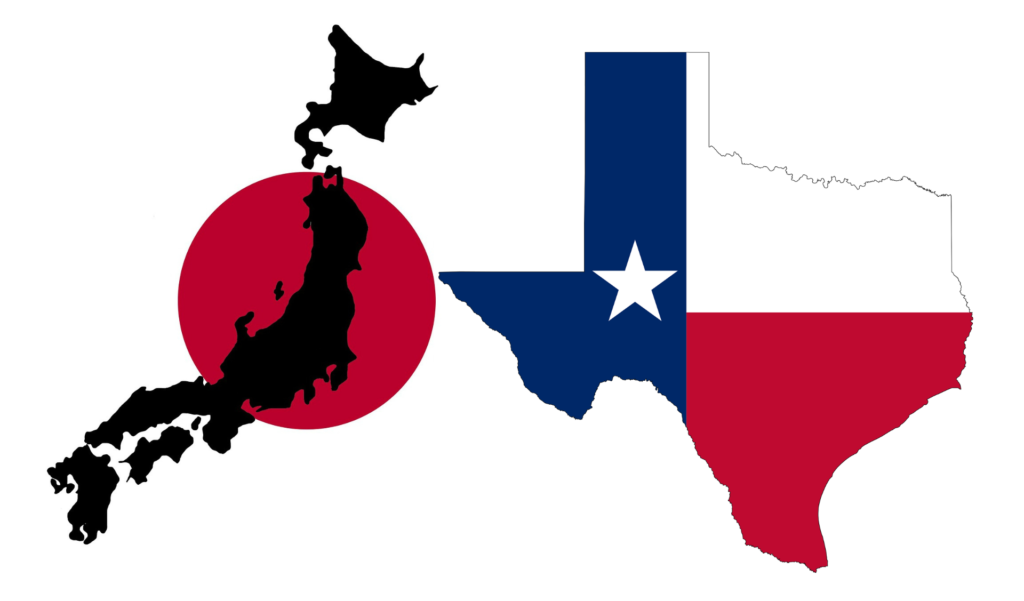When comparing geographical entities, the juxtaposition of Japan and Texas offers an intriguing study. Texas, a behemoth in the U.S., stretches expansively over the American Southwest, its reputation echoing with tales of cowboys, oil barons, and a fiercely independent spirit. Its vast landscapes traverse deserts, forests, and coastlines, each narrating a unique story of the American dream. Halfway across the globe, Japan, an archipelago ensconced in the Pacific Ocean, whispers tales of ancient samurai, intricate tea ceremonies, and cutting-edge technology. Its islands, although collectively smaller than Texas, pulsate with a dense population, and the cultural richness accumulated over millennia.

Table of Contents
The contrast between Texas’s expansive ruggedness and Japan’s compact intensity provides a fascinating lens through which we can explore the myriad ways geography shapes identity, culture, economy, and history. This article dives deep into these nuances, drawing parallels and highlighting differences, presenting a comprehensive tapestry of two distinct worlds.
Also read: Does it snow in Texas | Houston, Austin and San Antonio?
Land Area
Texas
Encompassing a vast area of approximately 268,596 square miles, Texas’s expansiveness provides a diverse range of habitats, from the swamps of East Texas to the arid deserts of the west. This vastness has greatly influenced Texan culture, contributing to its renowned spirit of independence and self-sufficiency.
Japan
Comprising 145,937 square miles, Japan’s archipelago stretches from subtropical zones to cooler temperate regions. The country’s mountainous terrain significantly influences its urban planning, with cities predominantly located in coastal regions or within valley interiors.
Population Density
Texas
Texas, while vast, has pockets of dense urbanization, particularly in cities like Houston, Dallas, and Austin. The state’s expansive rural regions provide a balance, resulting in an overall population density much lower than that of Japan.
Japan
Due to its smaller land area and a population of over 126 million, Japan is highly urbanized, with cities like Tokyo among the most densely populated in the world. The need for efficient use of space has led to innovations in infrastructure and housing.
Also read: Why is Austin the Capital of Texas
Geographic Diversity
Texas
From the piney woods of the east to the deserts and mountains of the west, Texas’s geographical diversity is significant. The state has a long coastline along the Gulf of Mexico, which plays a crucial role in its economy and culture.
Japan
Japan’s islands offer a tapestry of landscapes, from Hokkaido’s snowy expanses to Okinawa’s coral reefs. Japan’s geography has led to a deep appreciation of nature, evident in practices like “hanami” (cherry blossom viewing).
Climate Variations
Texas
Texas’s vastness leads to multiple climate zones. Eastern regions receive substantial rainfall, providing ideal conditions for agriculture, while the west’s arid conditions are suited for ranching. Coastal areas, meanwhile, are prone to hurricanes.
Japan
Japan experiences a wider climatic range than one might expect for its size. Coastal regions have milder climates, while the Japan Alps can have harsh winters. Japan’s typhoon season affects its southern and eastern coasts particularly.
Also read: How Big Is Australia Compared To Texas
Economic Contributions
Texas
Beyond oil and gas, Texas is a significant player in aerospace, biomedical sciences, and information technology. The state’s economy is so substantial that, if it were a country, it would rank among the world’s top 15 economies.
Japan
Japan stands as a technological and manufacturing giant. The country’s commitment to research and development, paired with a strong work ethic, has placed it at the forefront of industries ranging from electronics to automotive.
Culinary Landscape
Texas
The Lone Star State is a melting pot of flavors. Beyond barbecue and Tex-Mex, there’s a rich tradition of Southern cooking, Gulf Coast seafood, and even German-influenced dishes in areas settled by German immigrants.
Japan
Japanese cuisine is revered for its depth and complexity. From the umami-rich dishes of Kyoto to the seafood bounty of Hokkaido and the unique Okinawan diet, there’s a vast range to explore.
Also read: How Big Is Turkey Compared To Texas
Historical Context
Texas
Texas has a tumultuous history. It has been under six different flags Spanish, French, Mexican, Texan, Confederate, and American. This rich tapestry of cultural influences has left a lasting impact, from architecture to festivals.
Japan
Japan’s history spans millennia, from ancient Jomon settlements to the imperial court in Kyoto, the samurai era, the isolationist Edo period, and its transformation during the Meiji era. Each phase has left indelible marks on Japan’s cultural identity.
Also read: How Big Is Taiwan Compared To Texas
Conclusion
Both Texas and Japan, with their distinct landscapes and histories, exemplify the profound ways in which geography shapes societal evolution. Texas, with its vastness, tells a story of independence and diversity, while Japan’s compactness has fostered innovation and a deep communal spirit. Though differing in size and density, both regions boast a richness that resonates with cultural vibrancy, economic prowess, and historical depth. Their comparison serves as a testament to the unique stories places weave, emphasizing that while land area can be quantified, the essence of a region is an intricate blend of its people, traditions, challenges, and triumphs.
